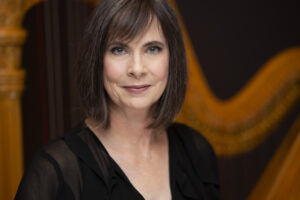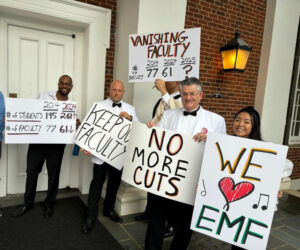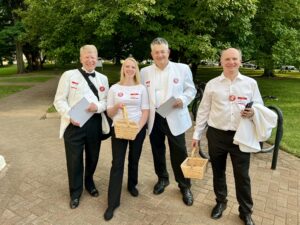
EMF Faculty Artists pose outside Dana Auditorium in the summer of 2024 in their red shirts in a show of solidarity.
Photo Credit: EMF Faculty Artists
During the summer of 2023, the Eastern Music Festival (EMF) faculty artists voted in favor of representation by the Charlotte Musicians’ Association (American Federation of Musicians Local 342).

Anna Kate Mackle
Photo Credit: theephotoninja.com
Founded in 1962, EMF is a five-week summer music festival for high school and college students, located in Greensboro, North Carolina. There are currently 61 faculty artists and approximately 280 students. Each week, the faculty teach private lessons, guide chamber music rehearsals, coach orchestra sectionals, and give masterclasses. In addition to our teaching responsibilities, we also perform on a weekly chamber music series and in the faculty orchestra under Music Director Gerard Schwarz.
For years, EMF had operated like a union organization without actually being one, with previous managements sitting down with the faculty Orchestra Committee each summer to address concerns and resolve issues. Things changed, however, when our current management came into power a decade ago; they still met with the OC each summer, but they continually failed to address the primary issues for the faculty such as pay, workload, job security, and housing costs. Consequently, those issues remained unchanged or, in some cases, grew worse. Faculty artist wages are only $200 more than ten years ago, while our workload has increased substantially. We do not receive any travel stipend to get to EMF each summer from our homes around the world, and while all staff, counselors, interns, and conductors receive free room and board, we do not; the cost of on-campus housing for my husband and myself at EMF comes out of our pockets and is higher than our mortgage payment at home.
In 2021, EMF management used pandemic restrictions as an excuse to fire fifteen faculty artists with assurances that the dismissals were temporary and that these faculty artists would be invited back the following year. These faculty artists, some of whom had worked at EMF for decades, were never invited back, and instead were replaced in the faculty orchestra by students and interns. We found it particularly disturbing that of the fifteen fired faculty artists, nine were women and three were people of color.
Even as faculty numbers have diminished, student enrollment surged, creating higher workloads for those of us who remain. Some faculty artists now teach two to three times the number of students we did pre-pandemic, and there are no longer enough of us to coach all of the student chamber ensembles.
We also have no tenure protection. Management refers to faculty artists as “seasonal employees” who only work for five weeks during the summer, even though we are expected to spend considerable time throughout the year making sure the festival will run smoothly. We are required to recruit students, create student audition requirements, coordinate auxiliary instrument acquisitions, plan masterclasses, listen to live auditions, evaluate audition recordings, and prepare student part assignments—all before the festival begins. In 2024, more than 800 students auditioned, all of whom were evaluated by the faculty. We receive no pay for any such activity during the year, nor is there any guarantee we will even be asked back for the upcoming summer for which we are expected to be actively recruiting during the fall.
At the beginning of the summer of 2023, management told us that our paychecks would be delayed until we all submitted new payroll paperwork. Only the faculty artists’ pay was impacted; the staff got paid on time. Faculty members immediately began to approach the OC about the need to unionize, not only to improve our pay and working conditions but also to provide a framework for the entire organization to function and communicate better. Over the next few weeks, OC members spoke personally with the rest of the faculty artists to gauge the interest in unionizing, and the response was overwhelmingly enthusiastic. The OC met with Rochelle Skolnick, Director of the AFM Symphonic Services Division, printed authorization cards, and called a faculty meeting, during which we discussed the various ways management had been ignoring and treating us with disrespect for the past decade. A majority of the faculty signed authorization cards on the spot, and by the end of the festival, 90% had been turned in.
At our annual meeting with management at the end of that summer the faculty artists arrived together, wearing black shirts in solidarity. Before management could speak, the OC stood and read a prepared statement announcing our intent to unionize, which was met with prolonged applause from the entire faculty. Then we all walked out.
One week after the festival ended we were notified that management refused to recognize us voluntarily, so we would be forced to hold an NLRB election. Over the next several months we met with AFM Negotiator and Organizer Todd Jelen to learn how management might try to influence our vote, so it was not surprising when we began to receive emails from board members and Executive Director Chris Williams. Ranging in tone from threatening (“It would be unfortunate if we could no longer respond to individual needs”) to disingenuous (“a ‘yes’ vote could change the familial atmosphere of this summer program”), these were obviously meant to scare and divide us, and they urged us to vote “No” no fewer than nine times in the final three weeks leading up to the election. The NLRB election was conducted by mail, and the vote count was witnessed by management and the OC chair via zoom. The election succeeded overwhelmingly, with 90% of the returned votes in favor of unionization.
When negotiations officially began in January, the faculty used management’s own operating document as a template from which to start bargaining a new CBA, but negotiations were bogged down for months by management’s distraction tactics and petty arguments about insignificant details. Their primary demand was, and remains, the “flexibility” to cut the faculty artists from the current number of 61 to 27, which would eliminate more than half the faculty artists’ jobs and eliminate the faculty orchestra altogether. It would also destroy the low student-to-faculty ratio that had been the vision of EMF’s founder, Sheldon Morgenstern. The very factors which have made EMF unique among summer festivals would be gone.

Faculty Artists (left-to-right) bass trombonist Christopher Davis, tubist Aaron Tindall, trombonist James Justin Kent, bassist Leonid Finkelshteyn (North Carolina Symphony), and clarinetist Natalie Hoe (The Florida Orchestra) picket with signs outside Dana Auditorium during the Eastern Music Festival season in 2024.
Photo Credit: Joy Hodges
As soon as the faculty artists arrived for EMF in June, we created a website and social media pages, formed action committees, and bought matching red shirts to wear to our actions and meetings with management. We greeted and leafleted patrons outside the hall before performances, escalating our message each week, and created contact sheets to be able to keep in touch with our supporters. We handed out hundreds of red buttons with the slogan “Faculty Cuts Impact EMF Students” and held a packed rally and concert at a local church to educate the public about our cause.
Management refused to negotiate with the OC at all during the festival, and repeatedly sent derogatory and blatantly false emails about us to patrons, board, and staff in an effort to turn the public against us. Photos of faculty artists were noticeably absent from EMF’s marketing materials, social media posts, and the faculty/student handbooks, and faculty artist photos were removed from their long-standing positions in the hall lobby. Staff members froze us out, only speaking to us when absolutely necessary, if at all. Lead negotiators from the board and management were witnessed withholding applause during faculty performances, and management called campus security on faculty members who were peacefully holding informational signs outside the hall.
When management learned that we were planning an off-campus rally and concert, they immediately sent a threatening email to the entire staff, forbidding anyone to assist us in any way and to report our activities to them. Then they booked an ice cream truck to visit the campus for the students shortly before our rally was to begin. The students, meanwhile, who had been extremely supportive of the faculty from the beginning, began posting flyers for our rally on GroupSpot, EMF’s internal communication app (where staff admins promptly deleted them). Each time the admins deleted a flyer, students would post another one, and they referred to the ice cream truck as “The Great Distraction”. On the day of the event, the students got their ice cream from the truck and enjoyed it on the walk to our rally.

Faculty Artists (left-to-right) violinist Dan Skidmore, percussionist Alison Chorn, bassist Leonid Finkelshteyn (North Carolina Symphony), and violinist Uli Speth pass out buttons to patrons during the summer of 2024.
Photo Credit: Anna Kate Mackle
Shortly after the students began wearing our faculty support buttons, EMF management warned them that “photographs of students attired improperly will not be published”, and students subsequently discovered that EMF was photoshopping the students’ own photos to share on social media, either by removing the buttons or cropping out students who were wearing them altogether. The students openly called out the censorship on GroupSpot and posted before and after photos on their social media pages to publicly shame EMF.
At the final faculty orchestra performance of the season, we held a five-minute moment of silence on stage in front of the audience just prior to the start of the concert. At 7:55 we all stopped warming up, put down our instruments and sat in silence. When the students in the audience noticed, they started to clap and cheer, and then the rest of the audience joined in. For the entirety of those five minutes the audience cheered and applauded us, and when EMF’s executive director, Chris Williams, grabbed a microphone and tried to talk he was repeatedly drowned out.
Since EMF ended in July there have been several negotiation sessions with a mediator, but little meaningful progress has been made. We continue to fight to keep faculty artist numbers at current levels, if not increase them, but management continues to insist on drastic cuts, despite a lack of evidence of any financial need for such cuts. They refuse to share EMF’s financial information with us, but it is clear that some on the board want to eliminate the faculty orchestra. EMF does not need short-sighted cuts; it needs leaders who have the vision and fundraising skills not only to preserve what has made this festival successful for the past 62 years, but to enable it to continue to grow and thrive for decades to come.
To learn how you can support the EMF faculty artists, please visit our website at: www.emffacultyartists.com, and like and follow emffacultyartists on facebook and instagram.





